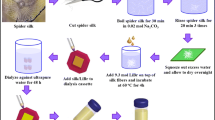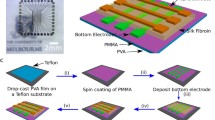Abstract
Memristors integrated with low operating voltage, good stability, and environmental benignity play an important role in data storage and logical circuit technology, but their fabrication still faces challenges. This study reports an ultra-thin bio-memristor based on pristine environment-friendly silk nanofibrils (SNFs). The intrinsic ionic conductivity, combined with high dielectric performance and nanoscale thickness, lowers the operation voltage down to 0.1–0.2 V, and enables stable switching and retention time over 180 times and 105 s, respectively. Furthermore, the SNF-based memristor device in a crossbar array achieves stable memristive performance, and thus realizes the functions of memorizing image and logic operation. By carrying out variable-temperature electrical experiments and Kelvin probe force microscopy, the space charge-limited conduction mechanism is revealed. Integrating with low operating voltage, good stability, and ultra-thin thickness makes the SNF-based memristors excellent candidates in bioelectronics.

摘要
兼具低工作电压、良好稳定性及环境友好性的忆阻器在数据存储和逻辑电路领域具有重要的作用, 但其制备依然是一个较大的挑战. 本研究报告了一种基于纯丝素纳米微纤(SNFs)的超薄生物忆阻器. 丝素纳米微纤的本征离子导电性、高介电性能及纳米级的厚度, 可将忆阻器的工作电压降低至0.1–0.2 V, 并使其实现了超过180次的稳定电阻切换及105 s的阻态保持时间. 此外, 基于SNFs的忆阻交叉阵列具备稳定的忆阻性能, 实现了图像记忆和逻辑运算功能. 电学变温实验和开尔文探针力显微镜的测试结果表明, 忆阻器的工作机制为空间电荷限制传导(SCLC)机制. SNFs基忆阻器的低工作电压、良好的稳定性和超薄厚度有望使其成为理想的生物电子器件.
Similar content being viewed by others
References
Zidan MA, Strachan JP, Lu WD. The future of electronics based on memristive systems. Nat Electron, 2018, 1: 22–29
Zhao X, Xu H, Wang Z, et al. Memristors with organic-inorganic halide perovskites. InfoMat, 2019, 1: 183–210
Zhao Q, Xie Z, Peng YP, et al. Current status and prospects of memristors based on novel 2D materials. Mater Horiz, 2020, 7: 1495–1518
Im IH, Kim SJ, Jang HW. Memristive devices for new computing paradigms. Adv Intelligent Syst, 2020, 2: 2000105
Liu C, Chen H, Wang S, et al. Two-dimensional materials for next-generation computing technologies. Nat Nanotechnol, 2020, 15: 545–557
Park HL, Lee Y, Kim N, et al. Flexible neuromorphic electronics for computing, soft robotics, and neuroprosthetics. Adv Mater, 2020, 32: 1903558
Lv Z, Zhou Y, Han ST, et al. From biomaterial-based data storage to bio-inspired artificial synapse. Mater Today, 2018, 21: 537–552
Kwak KJ, Lee DE, Kim SJ, et al. Halide perovskites for memristive data storage and artificial synapses. J Phys Chem Lett, 2021, 12: 8999–9010
Sun K, Chen J, Yan X. The future of memristors: Materials engineering and neural networks. Adv Funct Mater, 2021, 31: 2006773
Zhang J, Sun T, Zeng S, et al. Tailoring neuroplasticity in flexible perovskite QDs-based optoelectronic synaptic transistors by dual modes modulation. Nano Energy, 2022, 95: 106987
Yan X, Zhao Q, Chen AP, et al. Vacancy-induced synaptic behavior in 2D WS2 nanosheet-based memristor for low-power neuromorphic computing. Small, 2019, 15: 1901423
Kim KM, Zhang J, Graves C, et al. Low-power, self-rectifying, and forming-free memristor with an asymmetric programing voltage for a high-density crossbar application. Nano Lett, 2016, 16: 6724–6732
Zidan MA, Fahmy HAH, Hussain MM, et al. Memristor-based memory: The sneak paths problem and solutions. Microelectron J, 2013, 44: 176–183
Wang H, Yu T, Zhao J, et al. Low-power memristors based on layered 2D SnSe/graphene materials. Sci China Mater, 2021, 64: 1989–1996
Wang K, Li L, Zhao R, et al. A pure 2H-MoS2 nanosheet-based memristor with low power consumption and linear multilevel storage for artificial synapse emulator. Adv Electron Mater, 2020, 6: 1901342
Guo J, Wang L, Liu Y, et al. Highly reliable low-voltage memristive switching and artificial synapse enabled by van der Waals integration. Matter, 2020, 2: 965–976
Zhou F, Liu Y, Shen X, et al. Low-voltage, optoelectronic CH3NH3Pb−I3−xClx memory with integrated sensing and logic operations. Adv Funct Mater, 2018, 28: 1800080
Xu R, Jang H, Lee MH, et al. Vertical MoS2 double-layer memristor with electrochemical metallization as an atomic-scale synapse with switching thresholds approaching 100 mV. Nano Lett, 2019, 19: 2411–2417
Dai S, Chu Y, Liu D, et al. Intrinsically ionic conductive cellulose nanopapers applied as all solid dielectrics for low voltage organic transistors. Nat Commun, 2018, 9: 2737
Yan X, Pei Y, Chen H, et al. Self-assembled networked PBS distribution quantum dots for resistive switching and artificial synapse performance boost of memristors. Adv Mater, 2019, 31: 1805284
Gao X, Bian G, Zhu J. Electronics from solution-processed 2D semiconductors. J Mater Chem C, 2019, 7: 12835–12861
Cai W, Piner RD, Zhu Y, et al. Synthesis of isotopically-labeled graphite films by cold-wall chemical vapor deposition and electronic properties of graphene obtained from such films. Nano Res, 2009, 2: 851–856
Qian Q, Peng L, Perea-Lopez N, et al. Defect creation in WSe2 with a microsecond photoluminescence lifetime by focused ion beam irradiation. Nanoscale, 2020, 12: 2047–2056
Konar R, Rosy R, Perelshtein I, et al. Scalable synthesis of few-layered 2D tungsten diselenide (2H-WSe2) nanosheets directly grown on tungsten (W) foil using ambient-pressure chemical vapor deposition for reversible Li-ion storage. ACS Omega, 2020, 5: 19409–19421
Li S, Li Y, Shao Y, et al. Emerging two-dimensional materials constructed nanofluidic fiber: Properties, preparation and applications. Adv Fiber Mater, 2022, 4: 129–144
Zhao H, Dong Z, Tian H, et al. Atomically thin femtojoule memristive device. Adv Mater, 2017, 29: 1703232
Das M, Kumar A, Kumar S, et al. Effect of surface variations on the performance of yttria based memristive system. IEEE Electron Device Lett, 2018, 39: 1852–1855
Shi C, Wang J, Sushko ML, et al. Silk flexible electronics: From bombyx mori silk Ag nanoclusters hybrid materials to mesoscopic memristors and synaptic emulators. Adv Funct Mater, 2019, 29: 1904777
Wang W, Wang M, Ambrosi E, et al. Surface diffusion-limited lifetime of silver and copper nanofilaments in resistive switching devices. Nat Commun, 2019, 10: 81
Lv Z, Wang Y, Chen Z, et al. Phototunable biomemory based on light-mediated charge trap. Adv Sci, 2018, 5: 1800714
Niu Q, Huang L, Lv S, et al. Pulse-driven bio-triboelectric nanogenerator based on silk nanoribbons. Nano Energy, 2020, 74: 104837
Zhang M, Hu B, Meng L, et al. Ultrasmooth quantum dot micro-patterns by a facile controllable liquid-transfer approach: Low-cost fabrication of high-performance QLED. J Am Chem Soc, 2018, 140: 8690–8695
Wang Q, Su B, Liu H, et al. Chinese brushes: Controllable liquid transfer in ratchet conical hairs. Adv Mater, 2014, 26: 4889–4894
Chen YS, Lee HY, Chen PS, et al. An ultrathin forming-free HfOx resistance memory with excellent electrical performance. IEEE Electron Device Lett, 2010, 31: 1473–1475
Xu J, Zhao X, Wang Z, et al. Biodegradable natural pectin-based flexible multilevel resistive switching memory for transient electronics. Small, 2019, 15: 1803970
Xing Y, Shi C, Zhao J, et al. Mesoscopic-functionalization of silk fibroin with gold nanoclusters mediated by keratin and bioinspired silk synapse. Small, 2017, 13: 1702390
Rohaizu R, Wanrosli WD. Sono-assisted TEMPO oxidation of oil palm lignocellulosic biomass for isolation of nanocrystalline cellulose. Ultrasons Sonochem, 2017, 34: 631–639
Chang Y, Wang L, Li R, et al. First decade of interfacial iontronic sensing: From droplet sensors to artificial skins. Adv Mater, 2021, 33: 2003464
Dai S, Wang Y, Zhang J, et al. Wood-derived nanopaper dielectrics for organic synaptic transistors. ACS Appl Mater Interfaces, 2018, 10: 39983–39991
Kunwar R, Harilal M, Krishnan SG, et al. Pseudocapacitive charge storage in thin nanobelts. Adv Fiber Mater, 2019, 1: 205–213
Acknowledgements
This work was supported by the National Natural Science Foundation of China (51903045 and 52173031), the International Cooperation Fund of the Science and Technology Commission of Shanghai Municipality (19520744500), the Basic Research Project of the Science and Technology Commission of Shanghai Municipality (21JC1400100), Shanghai Rising-Star Program (22QA1400400), the Program of Shanghai Academic/Technology Research Leader (20XD1400100), the Fundamental Research Funds for the Central Universities and Graduate Student Innovation Fund of Donghua University (CUSF-DH-D-2020049). We thank Dr. Renwei Liu (Shimadzu) for the help in AFM, KPFM and XPS characterizations.
Author information
Authors and Affiliations
Contributions
Zhang YP and Fan S conceived and directed this research; Zhang Y performed the experiments, analyzed the data, and wrote the manuscript; Niu Q provided the method for preparing nanofibrils; Han F measured and analyzed the memorizing image and logic operation properties. All the authors contributed to the preparation of the manuscript.
Corresponding authors
Additional information
Conflict of interest
The authors declare that they have no conflict of interest.
Supplementary information
Supporting data are available in the online version of the paper.
Yi Zhang received her BSc degree in materials science and engineering in 2015 from Lanzhou University of Technology. She is currently a PhD candidate at Donghua University (DHU). Her research mainly focuses on biomemristors based on silk fibroin.
Suna Fan is an associate professor at the College of Materials Science and Engineering, DHU, China. She received her PhD degree in materials physics and chemistry from Jilin University, China, in 2017. From 2017 to 2018, she was an assistant professor at Wenzhou Institute of Biomaterials and Engineering, Chinese Academy of Sciences (CAS) (renamed as Wenzhou Institute, University of CAS in 2019). She joined DHU in 2018 and is working on the research of silk-based smart materials and conducting polymers.
Yaopeng Zhang is a professor at the State Key Laboratory for Modification of Chemical Fibers and Polymer Materials, DHU, China. He received his PhD degree in materials science from DHU in 2002. From 2004 to 2007, he was a postdoctoral research fellow at the Kawamura Institute of Chemical Research, Japan. He served as a visiting scholar at Akita University, Japan and Stony Brook University, USA. His current research focuses on silk materials for biomedical and bioelectronic applications.
Rights and permissions
About this article
Cite this article
Zhang, Y., Fan, S., Niu, Q. et al. Intrinsically ionic conductive nanofibrils for ultra-thin bio-memristor with low operating voltage. Sci. China Mater. 65, 3096–3104 (2022). https://doi.org/10.1007/s40843-022-2115-6
Received:
Accepted:
Published:
Issue Date:
DOI: https://doi.org/10.1007/s40843-022-2115-6




